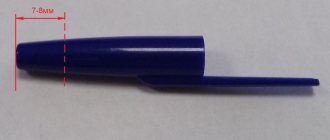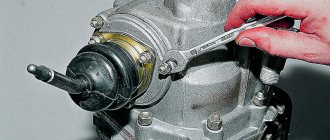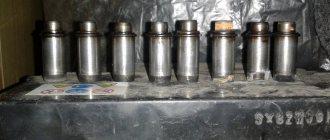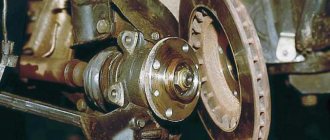There are now a dozen CNG filling stations along the Moscow Ring Road and inside it. There are gas stations on the main routes. Unless the western direction is completely deprived of them. The most extensive network is in the south: in Rostov-on-Don, Stavropol and the Caucasus.
My path lies to the southeast. Deciding that Moscow alone cannot check the car, I leave the capital along the M5 Ural highway, move along the Shilovo-Kasimov link to the Yegoryevskoe highway and return home along it.
One day and about 800 km. According to the Internet, the infrastructure I need is on the route.
Lucky or unlucky
Largus was given to me filled to capacity with both gasoline and gas. Therefore, I boldly drink to Ryazan. From the moment of refueling, almost 300 km of mileage will be accumulated, for which, as I expect, the gas cylinder will be enough. It is 90-liter and holds up to 22 m³ of methane.
I've arrived! Of the five local CNG filling stations, one is located simply ideally - right on the bypass road. The price is communist: 14.6 rubles per cubic meter of methane.
I count and don’t believe the result. At this price, a kilometer costs one ruble (if you take into account only fuel costs). Gasoline is three times more expensive! And this is on the basis that consumption per hundred will not exceed seven liters, which Largus, which has the aerodynamics of a brick, still needs to be persuaded to do.
The next point of my mini-run required luck. There is only one gas filling station in Kasimov. If it doesn’t work, it’s another hundred kilometers to go to the nearest one. She is in Murom, from where she will have to return to Moscow along the already busy Gorkovka, which is not part of my plans.
Luck is on my side again! However, the price is already 17 rubles per cubic meter, so the cost per kilometer on the second cylinder rises to 1.3 rubles. But this is also a fantastic saving compared to gasoline.
Having set a course for Moscow, I did not foresee any difficulties. The next station is already on the Moscow Ring Road, and, as experience has shown, there is just enough reserve for 300 km before it... The gas ran out literally a kilometer before the destination. But I couldn’t replenish its reserves. Two pumps, two attempts at each, half an hour of wasted time, but the fuel never arrived at Largus. What the automatic refueling didn’t like remains unknown.
The nearest CNG filling station is fifteen kilometers one way. Given the evening traffic jams, such a pastime smacks not of economy, but of idiocy, so I’m going home. And Largus is forced to travel fifty kilometers on gasoline. In a traffic jam cycle this is about five liters. Not much, but I’m focused on saving!
The following days passed in the rhythm of the city. The highway range of about 300 km was reduced to 200–220 km (depending on the number of traffic jams). The cost per kilometer reached one and a half rubles, still remaining at an abyss away from the “gasoline” (with a consumption of 10 l/100 km and refueling AI-92, this is 4.2 rubles per kilometer).
Propane or methane: which is better?
Both gases have a number of advantages over traditional fuels, which is why their use is becoming more and more popular. Propane differs from methane in many ways, including the principles of storage and use as a primary fuel. It is more common because installing equipment using this gas is cheaper than using methane. But the latter is cheaper on its own and theoretically will pay for itself faster than a propane system. Methane and propane affect engine power, reducing it by a certain percentage. If propane has an indicator of no more than 5% at speeds above 120 km/h, then methane “eats” about 20%.
Propane contains impurities and cannot be considered environmentally friendly, although it is much cleaner than gasoline.
Methane is comparable in environmental friendliness to alcohol, solar or electrical energy. It is one of the cleanest fuels on the planet. Methane is heavier than propane, which is compressed under pressure. The cylinder of the latter weighs less, and the volume of gas in it is larger, which allows you to travel a greater distance than with the same volume of methane.
In terms of explosiveness, methane is superior to almost all other types of fuel. Due to its thicker walls, the cylinder with it is slightly damaged in an accident. Today it is propane that is most often found. Finding a gas station with methane will be problematic, especially in small towns. For clarity, check out the comparative table of the pros and cons of two types of gas:
Bury your money
The bi-fuel station wagon is 72,000 rubles more expensive than the usual one. In the best case, if the car saves two rubles per kilometer, it will take 36,000 km to recoup the overpayment. With intensive use this is less than a year, and for less active drivers - at least two.
This is the ideal situation. And, I must say, those wishing to subject it to inspection have already lined up.
Only a few will be lucky to have a CNG filling station clearly on the route. This means that we will take into account the mileage only for gas stations. In my case it is 25 km round trip. That is, every 200–300 km I have to deduct at least 25 rubles from the hypothetical savings, and if I drive in the urban cycle - under 40 rubles.
Maintenance of the dual-fuel version is significantly more expensive. For the first four services, you will overpay, for example, 12,300 rubles in Moscow, and 11,600 in Togliatti. Not so little: you will have to pay several thousand more kilometers.
And one more minus that promises additional expenses. The owner of a regular Largus will transport the bulky cargo himself by folding the back seat. The owner of the methane version will look at the gas cylinder installed across the body and begin to call the gazelles “on call”.
Finally, an intangible but unpleasant point is the lack of dynamics. AVTOVAZ honestly declares the loss of 12 “horses” when the engine runs on methane. Remembering the former editorial propane-butane Almera, similar in power and temperament to Largus, I did not expect much disappointment. However…
Either the Nissan had less loss of power, or it was leveled out by the automatic transmission, but the Largus loses very noticeably in traction and elasticity. So much so that before overtaking each truck overtaken on the narrow Yegoryevskoe highway, an inner voice persistently whispered: “Do you need it?” “We have to,” I answered, cranking into third as the engine strained.
On climbs, no, no, and even switched to fourth and without overtaking: on the highest, Largus refused to maintain the accumulated 80–100 km/h. And this is an empty car! Do not consider a filled cylinder as a serious load on the driver. Methane teaches not only economy, but also measured driving.
Saving for a week was fun and educational. Several years of daily use - no thanks. In addition, choosing a Lada with a CNG “prefix” dooms you to drive with a manual transmission (they don’t install a robot on the Vesta CNG either), which is a significant disadvantage in my eyes. I’ll leave this pleasure to fans of overcoming difficulties and saving at any cost. I'll wait myself. At a minimum, an increase in the number of CNG filling stations.
| The amounts in fuel receipts are encouraging | It takes a long time to recover the overpayment, overcoming permanent difficulties |
Lada Largus CNG
Length / width / height / base
4470 / 1750 / 1670 / 2905 mm
Trunk volume (VDA)
300 l
Curb / gross weight
1450 / 1790 kg
engine
, P4, 16 valves, 1596 cm³;
78 kW / 106 hp (69 kW/94 hp)* at 5800 rpm; 148 Nm (135 Nm) at 4200 rpm Acceleration time 0–100 km/h
13.7 (14.5) s
Maximum speed
162 (155) km/h
Fuel / fuel reserve
AI-92 / 50 l;
methane / 90 l or 22 m³ Fuel consumption: combined cycle
7.7 l / 100 km (8.0 m³ / 100 km)
Transmission
front-wheel drive;
M5 * In parentheses hereinafter - data when operating on methane.
RESTYLING?
- The Russian Largus has been made since 2012, and the original – the Dacia Logan MCV station wagon – is already 13 years old.
- Last summer there were minor changes to the car, but you can’t call it restyling even if you wanted to. The Largus had their emblems and radiator grille changed. LADA on the stern is now written in spaced letters, like on other Ladas.
- On cars with luxury trim levels, they began to paint the body pillars black and tint the rear hemisphere.
- All Largus were also given new seat upholstery and headlights that go off when the ignition is turned off. The latter function, due to the absence of a light sensor and running lights, is very useful.
- That's all, don't expect X-face. The test Largus CNG is still “pre-reform”.
Largus ranks seventh in our market in terms of sales, and the plant is in no hurry to spend money on upgrades.
Gas equipment for Lada Largus
Today, the rate of increase in gasoline prices can significantly hit the pockets of a fairly large contingent of motorists. In such a situation, many are inclined to install gas equipment on their “horse”. This measure will be very relevant for those car owners who spend a long time behind the wheel, because it inevitably leads to tangible financial savings due to lower gas prices. The amount of money spent on installing gas equipment on the Lada Lagrus pays off quite quickly. To understand the degree of effectiveness of such equipment applicable to the Lada Largus model, one should study in more detail the operating features of the gas equipment, and also decide on the generation of this equipment, which will be as effective as possible for a Russian station wagon. Thus, complete clarity will be achieved regarding the advantages and negative aspects regarding HBO, after which you can safely proceed directly to the installation.
General provisions
LPG for Lada Lagrus is a special equipment consisting of a certain set of components that together allow the car to run on gas. This equipment is positioned as an alternative to widely used types of fuel (gasoline and diesel). Note that the last two types of fuel are “gaining” in price by leaps and bounds. And the installation of special equipment is very popular.
Some clients who apply for the service to connect gas equipment are not even able to decipher the abbreviation “GBO”. The main goal of installing gas equipment is the desire to reduce fuel consumption. If the owner is subject to a long stay on the road, then he will notice such savings quickly. This is where equipment installation comes into play.
A significant nuance when installing LPG on a Lada Lagrus, which can scare off many customers, is the “absorption” of free space in the car, because gas will require a separate container, since it cannot be poured into the fuel tank. For these purposes, manufacturers of such equipment have provided a special cylinder, which in the vast majority of cases is integrated into the luggage compartment of the car.
Disadvantages of HBO
The downside is the high cost of installing the equipment. LPG for Largus is estimated at no less than 30,000 rubles including installation. These investments are like a deposit in a bank - the benefits will only come after the equipment has fully covered the costs of purchase and installation.
Power reduction
The burning rate of gas is 20% lower than gasoline, and accordingly, engine power is reduced. This is especially felt when overtaking, when you need to accelerate quickly. At the same time, the ride is smoother, and dips are felt less during transitions. Installing an LPG involves re-equipping the vehicle’s structure, and there is a need for regular maintenance. With gas, the engine will require more careful maintenance. The frequency is reduced to once per 10 thousand km.
Increased weight and reduced usable space
The increase in weight can be considered a relative disadvantage, but one cannot but agree with the reduction in luggage compartment. It is in the trunk that the gas cylinder in the Lada Largus is most often located. The cylindrical tank “eats up” a significant part of the free space. A toroidal cylinder is installed under the bottom instead of a spare wheel.
The spare wheel is stored in the trunk and takes up space, which cannot be called a positive thing.
Difficulties with the power system
When installing LPG, problems may arise with the gasoline power system. Diagnosing faults becomes difficult due to the fact that the supply of both gas and gasoline is carried out through units that are in close interconnection. Access to the elements of the gasoline power system becomes significantly more difficult, as does repair work.
If problems occur with the gas supply, contacting a regular car service may be useless - not every car mechanic has the appropriate qualifications. In large cities this is not a problem, but in small towns the issue becomes acute.
Registration and parking
In some underground parking lots, parking of cars with LPG is prohibited. This is due to the chemical properties of propane - it is heavier than air and lingers in low points, while it evaporates slowly. A car with gas equipment cannot remain for a long time in closed garages with an inspection hole for the same reasons. Installing gas equipment involves making changes to the design of the car, and therefore is subject to mandatory registration with the traffic police. This is another argument in favor of the need to install equipment in a specialized company.
The traffic police will require you to present documents about all changes made. Self-installation without permission is illegal, and it will be impossible to register the vehicle with the traffic police. It is also impossible to register or deregister such a car, just like undergoing maintenance and obtaining MTPL insurance.
Other disadvantages
It is often difficult to sell a gas-powered car. This is due to the fact that many car owners have a negative attitude towards HBO. You can try to hide the elements of the gas equipment system from an inexperienced buyer, but this will require costs. Some even dismantle the LPG before selling it for subsequent installation on another car. In this case, you can save at least half the amount on installation.
There are much fewer gas stations with gas than with gasoline. This is due to higher safety requirements, as well as the complexity of gas transportation and storage. The cylinder with this fuel is refilled more slowly, requiring constant monitoring of the process by the operator. He must undergo training and have a clearance group. As a result, there are not so many such gas stations.
About the operating principle of HBO
Here we will delve a little deeper into the features of the operating principle of the equipment in relation to the Largus model we are considering. The cylinder itself, which contains the gas that serves as fuel, is a sealed tank. Fuel supply is done like this. Liquid gas, moving from a tank at a certain pressure, is supplied to a special device called a reducer, where it evaporates. Next, in gaseous form, the fuel is supplied to the mixer through installed nozzles located in a special gas injector, and then to the combustion chambers. This approach makes it possible to achieve uniform distribution of the mixture, which is very important for injection engines.
Most experts and mechanics, due to the use of distributed injection of the fuel mixture in Largus, are inclined to believe that it is necessary to install LPG on the Lada Lagrus exclusively in the 4th position. Whether to listen to this point of view or not is up to each client individually. Note that this generation of equipment is a higher quality and balanced system compared to previous generations. It is characterized by higher quality, reliability and better efficiency.
Installing an LPG on a Lada Lagrus on your own is very problematic, since in addition to specialized equipment, you will need a certain kind of skills. Before making such a decision, you should soberly assess your capabilities, because incorrect installation can lead to significant problems, in order to subsequently eliminate them, you will definitely need to contact the service, and this is not cheap.
Advantages of gas cylinder equipment
The main advantage of using gas as fuel is saving money. Gas consumption in Largus is about 20% more than gasoline, but the cost of the former is almost half as much. The savings and payback of installing LPG are felt during intensive use of the vehicle.
With a mileage of less than 10-15 thousand kilometers per year, switching to gas is not financially profitable. You also need to think about the feasibility of HBO if the car consumes 6-7 liters of gasoline per 100 km. With low fuel consumption, gas equipment may not pay for itself at all. The use of both gas and gasoline will be appreciated by motorists who often drive long distances, as the range without refueling increases significantly. The likelihood of refueling with low-quality fuel at a gas station far from the city is significantly reduced.
For the highway, gasoline is usually used, as it allows you to maintain traffic intensity with frequent acceleration when overtaking. In populated areas, gas is more often used, because a lot of power is not needed to move in traffic.
Gas and internal combustion engines
A properly configured gas system ensures quiet and stable operation of the engine. This is explained by the same high octane number. When driving on gas, there is a decrease in vibration and noise. The level of emissions into the atmosphere is noticeably lower, although in our country this is not given as much attention as in Europe. Gas even has a beneficial effect on the engine - liquefied fuel enters the combustion chambers in the correct gaseous state. Gasoline does not have such properties, but engineers are trying to bring the air-fuel mixture as close as possible to the gaseous state.
Ignition when using LPG is more efficient, the fuel burns evenly and slowly, and the load on the pistons is reduced. A gas engine wears out slowly. When burning, the gas does not leave carbon deposits on the cylinder walls, the oil retains its lubricating properties longer and needs to be replaced less frequently. Therefore, theoretically, an internal combustion engine running on gas lasts longer.
Environmental friendliness
The exhaust of the air-fuel mixture of air and gas is less toxic. The gas does not contain sulfur or additives. In terms of environmental friendliness, this fuel is three times better than gasoline. Only electric and hydrogen fueled cars are less toxic. In the CIS countries, the requirements for reducing the level of carbon dioxide from the exhaust system are not so stringent, but it is quite possible that they will be tightened, which means that the popularity of gas equipment may increase sharply.
How is the equipment installed?
Before installing LPG on LADA Largus, you should decide on the location of the cylinder. In most cases, such a place is a niche in the luggage compartment, where the spare wheel should initially be located. Experienced owners have an idea of the appearance of the cylinder when the car is on gas. It has a round shape, for which it was popularly nicknamed “donut”. During the installation of this equipment, a problem often occurs, which is the lack of a suitable place where the spare tire could be conveniently located. It cannot be said that this difficulty is associated with a global nature, since in this universal body any owner is able to rationally manage the free space.
When installing a proprietary gas system on a LADA Largus, the owner is required to create, along with the standard gas tank hatch, the same device designed to connect gas refueling equipment. Reviews from owners indicate that this is not labor-intensive.
If a specialized center has carried out high-quality installation of gas cylinder equipment, then no side effects or malfunctions arise during operation. Gas equipment will delight the owner for a long period of time with trouble-free functionality and savings on fuel.
According to reviews from owners, the only nuance during operation will be the requirement to ensure timely replacement of lubricant in the engine. Also, on 8-valve versions of the power unit, you will need to periodically adjust the valves every 30 thousand km of the distance traveled. This is due to the specific nature of this type of fuel, such as gas, which can cause valve subsidence. Also, we should not forget about the octane number, which is characteristic of gas and is equal to 96-100 units, which is more than that of gasoline.
LPG on LADA Largus requires the presence of indicator lamps in the cabin that characterize the operation of the system. Usually there are two such indicators and they are located on the front panel. The initial start of the engine is assumed to be on gasoline. In this case, one of the lamps is in flashing mode. After the engine warms up, the antifreeze reaches the required temperature, which allows the special valve to be activated. Now gas access to the system is open and the gas engine is switched to run on this particular fuel. This “event” is indicated by the inclusion of a second, green light.
To make it possible to diagnose HBO, there is a corresponding connector in the engine compartment. This is required in case of various types of failures or malfunctions that may occur if gas equipment is installed on the car. As a rule, the entire equipment installation procedure will not require more than one day.
Equipment selection
Among the popular manufacturers of gas equipment, these are the brands that are most often found on the market:
- Lovato. The Italian manufacturer has established itself in the European market, and its products are also highly rated in the CIS. A distinctive feature is that the equipment is produced in an aluminum sealed block - so it is reliably protected from moisture. Systems from Lovato offer the optimal price-quality ratio. The equipment includes a complete set, high-quality electronics are noted. The brand has been represented on the Russian and CIS markets for a long time, so there are no problems with spare parts. Structurally, there is nothing complicated in the HBO from Lovato, so it is inexpensive and reliable. Among the shortcomings, there are failures in the operation of the gearbox at low temperatures. Spare parts are cheap, but repairs are relatively expensive. Units are rarely repaired, since it is cheaper to replace them as an assembly. There are also many fakes on the market.
- PRINS. The Dutch company, which has been in the gas equipment market for 25 years, was in fact at the origins of the production of gas equipment for cars. The products are of high quality and are constantly being modernized. The brand is elite in its own way, so the prices are high.
- STAG. The Polish company is one of the five best manufacturers of electronics for gas equipment. The list of products includes equipment sets and components for them. STAG focuses on quality and long service life, low prices and ease of operation. Equipment with a Russified menu is produced for Russia.
- ATIKER. Company from Turkey. LPG complies with European standardization standards ISO 9001:2000 and is certified ECE R 67-01. All products are necessarily tested and tested. Their main feature is good quality at an attractive price. Having the appropriate licenses, the company copies equipment from famous Italian manufacturers. The product list includes complete HBO sets, which are attractive with their low price. Among the shortcomings, the quality of components is not the best, so repairs are required more often. The rubber elements of the system wear out faster.
The world-class Italian company BRC produces high-quality products and gives them a long guarantee. According to representatives of the company, the LPG system can last at least 300 thousand kilometers without failures. All components are manufactured in one plant, which ensures perfect consistency. But on the Russian market, BRC products are one of the most expensive, the dealer network is poorly developed, and problems may arise with the acquisition of original spare parts.
About the advantages and disadvantages of HBO?
Before installing this equipment in a specialized service center, the car owner should consult with specialists about the positive and negative aspects of operation that he may encounter in the future, and also study the reviews of the owners. We have already talked about the main positive aspects of gas equipment on the LADA Largus, and now we will present several negative aspects that the future owner of gas equipment will need to face.
- It is no secret that the cost of purchasing and installing the complex we are considering is very high. Therefore, before installation is carried out, the owner will need to acquire sufficient financial resources.
- The next important point is the need to register equipment with the traffic police. This procedure involves entering into the registration document information regarding the use of gas as fuel. To ensure the opportunity to register an LPG, the owner will need to submit a certain package of documents to the inspectorate, after which authorized traffic police officers will carry out the entire range of procedures related to registration.
- Difficulty refueling on country roads. If in urban areas it is not difficult to find the required gas station, then in suburban areas there may not be such a “point”. Here the owner will need to show prudence in order to protect himself from such situations. It is recommended to fill the gas tank completely before a long-distance voyage. Since the process of gas consumption occurs much more slowly than gasoline, such a reserve is usually enough for owners to cover long distances.
Now let's move on to consider some more important advantages that gas-cylinder equipment has.
- As you know, compared to gasoline, gas is a cleaner fuel. This fact allows you to avoid the need to clean fuel equipment, because no harmful impurities or other contaminants remain in the circuit. This circumstance also ensures the absence of carbon deposits that appear on the elements of the drip mechanism and parts of the piston group during the combustion of the fuel mixture.
- As already noted, gas equipment allows you to quickly recoup the costs incurred for the purchase and installation and provides considerable savings in further operation.
Effect of gas on the engine
Gas actually does not affect the power plant in any way and does not harm it, but the equipment and engine must be set up by qualified personnel. Only in this case is the uninterrupted operation of the motor guaranteed. Owners are required to strictly adhere to the rules for operating gas equipment. Negligent attitude towards equipment and the rules for its use has led to the emergence of the myth that gas spoils the engine and reduces its service life.
The argument is given that the gas has a higher octane number (from 100), which leads to burnout of the valves. In fact, this is not so - with proper configuration, no problems arise when using gas as fuel. The air-fuel mixture should not be lean or, conversely, rich; this can lead to malfunctions and a decrease in engine life, both in the case of gasoline and gas. A rich mixture damages the catalysts, the exhaust system burns out, and the engine runs unstable.
A mixture that is too lean increases the combustion temperature, as a result the valves burn out and the engine overheats. The problems develop further - popping noises begin in the exhaust system, as the spark plugs do not work correctly. The combustion process of fuel in the cylinders is disrupted. All this leads to complete failure of the motor.
Let's sum it up
As we found out, installing LPG on the Lada Lagrus, as well as on any other car suitable for these purposes that can run on gas, will be a justified action if the owner has to spend a long time traveling. This is evidenced by numerous reviews from owners. The installation process itself is associated with certain difficulties, involving the installation of a cylinder and reducer, laying lines and other actions, and therefore is characterized as quite expensive. Only after HBO is installed on the Lada Lagrus, the owner is fully able to experience the delights of this alternative to the standard power system. What type of fuel to use is up to each owner to decide independently, but as you can see, a gas engine is very economical.
How we transferred the Lada Largus to LPG (virtually) without loss of power
Leave a request and get a -20% discount on wheel alignment!
How we transferred the Lada Largus to LPG (virtually) without loss of power
At the end of last year, our company got a new company car - Lada Largus 2021, 1.6 petrol.
Since we well understand the benefits of installing gas equipment in terms of fuel consumption and careful operation of the engine, immediately after the purchase we installed Landi Renzo EVO LPG on the Lada.
1,000 km after installing the LPG, we decided to check how gas equipment affected the engine power.
How our Lada Largus was tested on a dynamometer stand can be seen in the video.
What does it mean?
Car owners who are thinking about switching to gas often abandon this idea only because they learn about the “inevitable” loss in power when installing LPG. Depending on the car model, the equipment used and the ECU firmware, losses can be up to 10-15%. For individual engines this is a very noticeable difference, which the owner feels in terms of acceleration dynamics and confidence in maneuvering.
Our experience with installing LPG on the Lada Largus clearly shows that by investing once in a high-quality LPG and installing it in a certified center, the owner will subsequently save on fuel, and the acceleration dynamics and torque of the engine will not be affected.
We sent the results with the conversion of our Lada Largus to gas and an offer of cooperation directly to the manufacturer to the dealership.
We received a response from the official Lada dealer in Belarus.
Thus, the result of our work on installing Landi Renzo EVO LPG on a ben-free Lada Largus was noted and highly appreciated by the manufacturer himself.
What's the secret?
Of course, such brilliant results are impossible without choosing reliable Italian equipment from Landi Renzo .
We have been working with the manufacturer Landi Renzo for 20 years. And all these years we have only become more convinced of our choice and the reliability of this brand.
So for our Lada Largus we chose the 4th generation Landi Renzo EVO kit.
Very little effort and time is spent on installation, and then, like in a fairy tale: I sat down and drove off. No additional work, settings, rechecks - only economical, quiet and efficient operation of the engine on gas.
Landi Renzo EVO kit is easy to install, has a self-calibration function, and is suitable for our climate and gas: propane-butane mixture, which is sold at Belarusian gas stations.
- After installing Landi Renzo EVO on a car, the environmental friendliness of the exhaust increases by one class. In our example, the Lada Largus complied with Euro-5 eco-standards, but now it complies with Euro-6.
- The reducer is designed for use in propane-butane systems, contains a solenoid shut-off valve for greater safety and is suitable for 4-cylinder engines up to 110 kW.
- Italian gas injectors are considered the best among competitors; they are resistant to various fuel contaminants and have a long service life.
- The petrol/gas switch, which is installed in the passenger compartment, will not only fit well into any car interior, but will also show the level of remaining gas in the cylinder, and when the fuel level is low, it will sound a reminder to the driver.
Another secret of our result in converting Lada Largus to gas is the firmware, due to which the electronic engine control unit supplies fuel to the cylinders so that the engine does not actually lose power. As was the case in our case.
Do you want the same?
Our experience in converting the Lada Largus to gas, the ECU firmware used and high-quality Italian equipment - all this suggests that any car produced by AvtoVAZ with a 1.6 petrol engine can be converted to gas without any actual loss of power. After all, a 1.6% loss of torque will not in any way affect the speed gain and driving comfort.
Do you want to reduce fuel costs and avoid detonation and coking of engine cylinders, and switch to environmentally friendly and inexpensive fuel - gas?
Then welcome to the installation of gas equipment in.
The first 50 owners of cars manufactured by AvtoVAZ receive a 2-year warranty on the installed gas equipment without mileage restrictions.
- See photo reports of our other works in the gallery.
Standard LPG Lada Largus
in 2021 announced the release of Lada Largus CNG (the abbreviation translates as compressed natural gas). According to the automaker's plan, a test batch of Largus with gas equipment was tested in large taxi fleets, after which it was supposed to go to all official dealers. The percentage of sales of cars with LPG turned out to be lower than that of conventional gasoline versions. The same situation was observed in the case of Vesta Cross CNG. This is not surprising considering that the price of the modification with gas has increased by almost 100 thousand rubles. As representatives of AvtoVAZ stated, the cost will be recouped by savings in fuel costs after 45-50 thousand kilometers. The only thing they did not take into account was the fact that installing 4th generation gas equipment using your own funds would cost half as much and pay off twice as quickly. Gas versions are used in the fleets of budgetary organizations as official vehicles.










